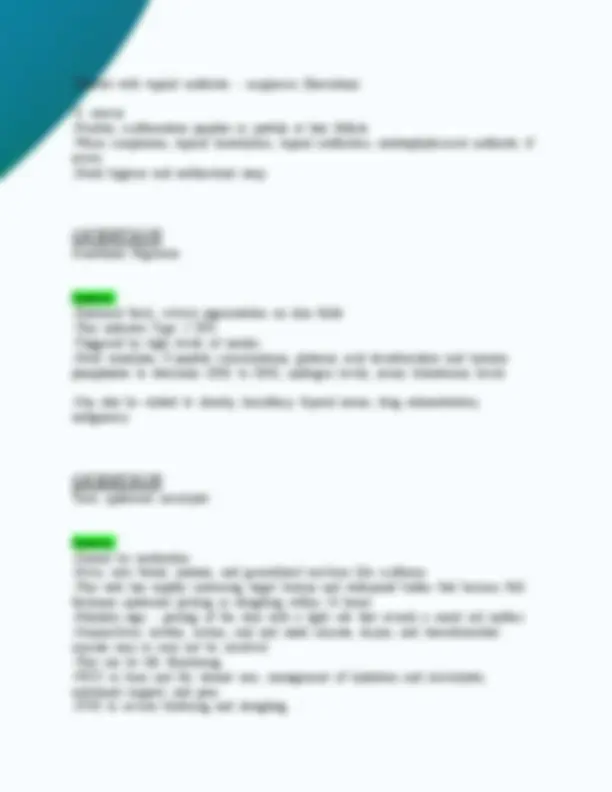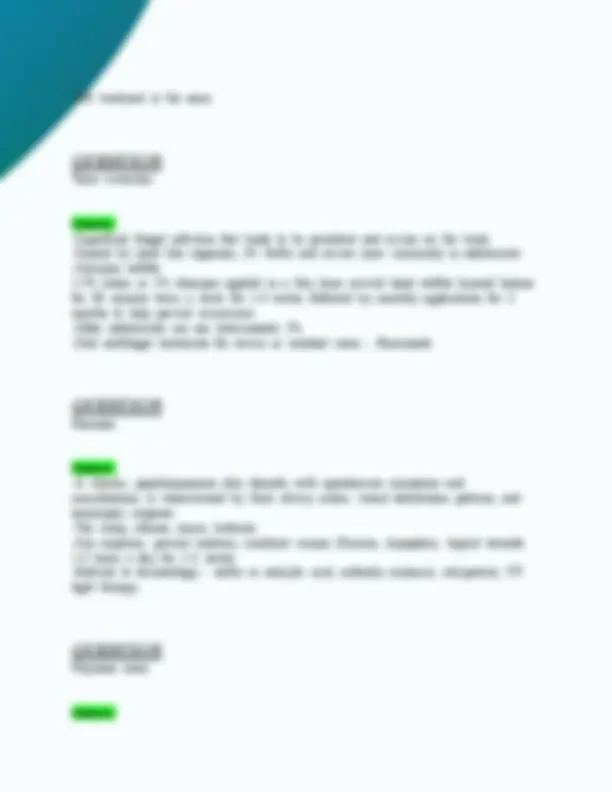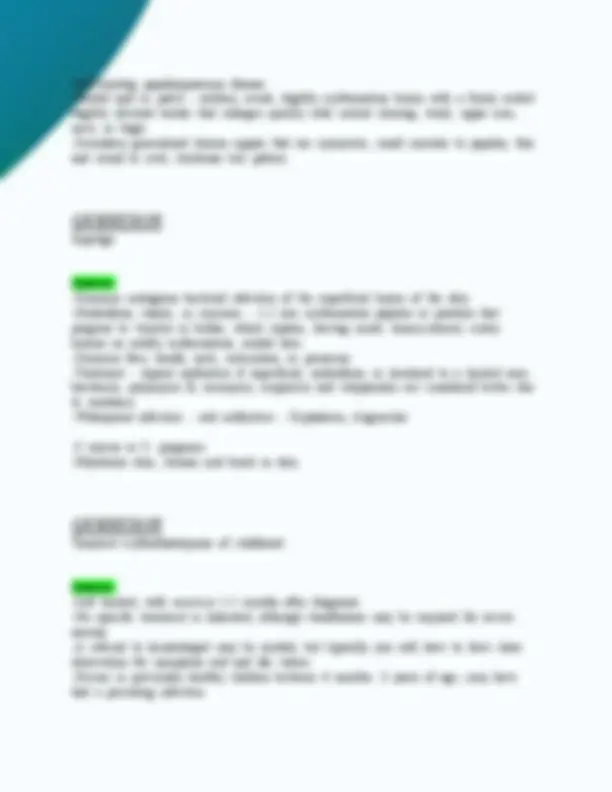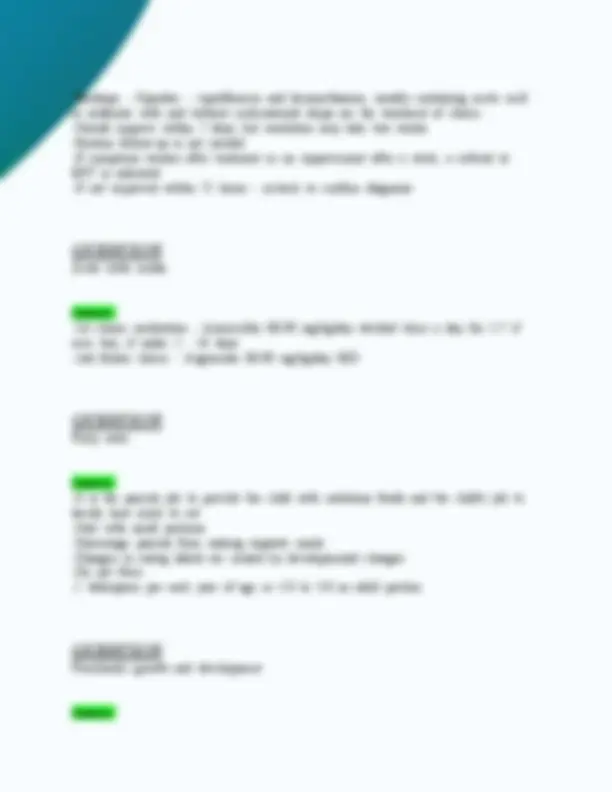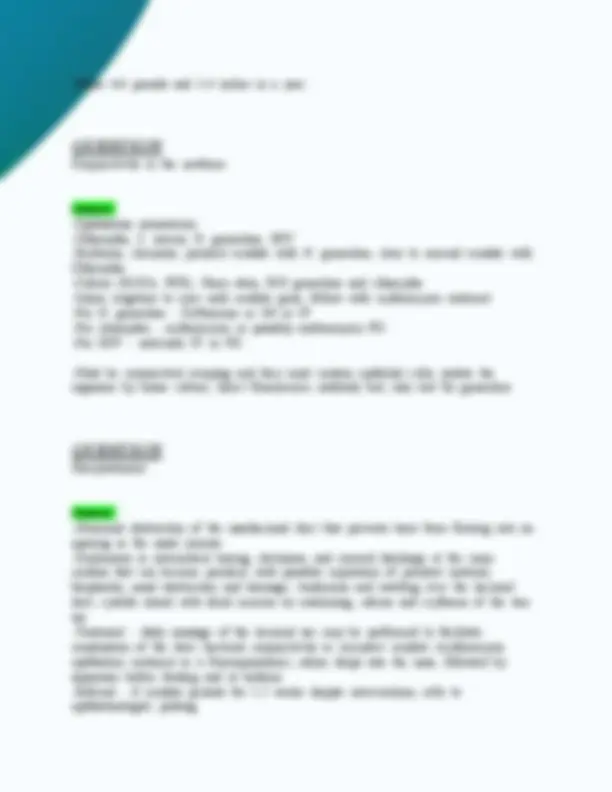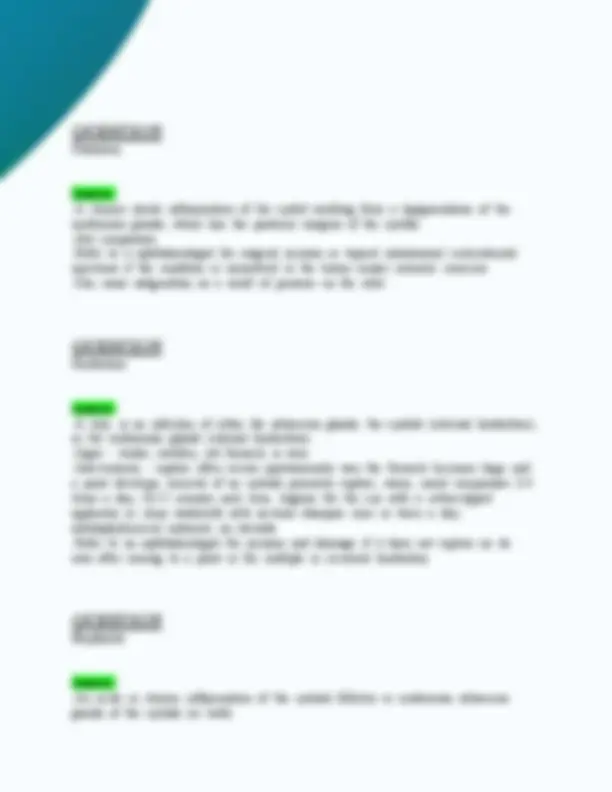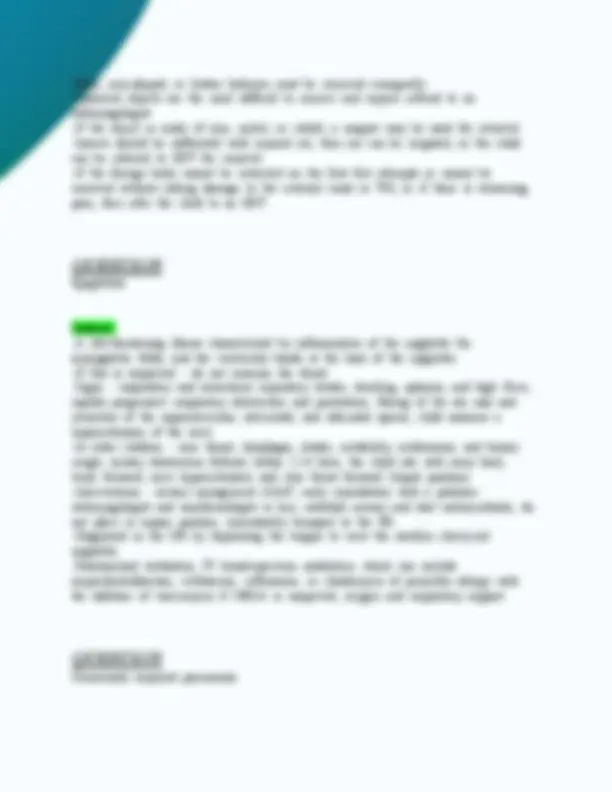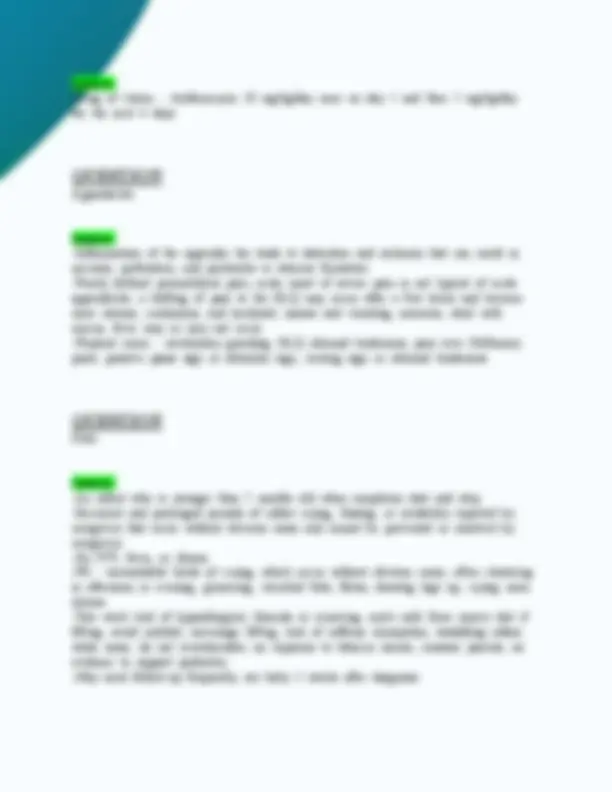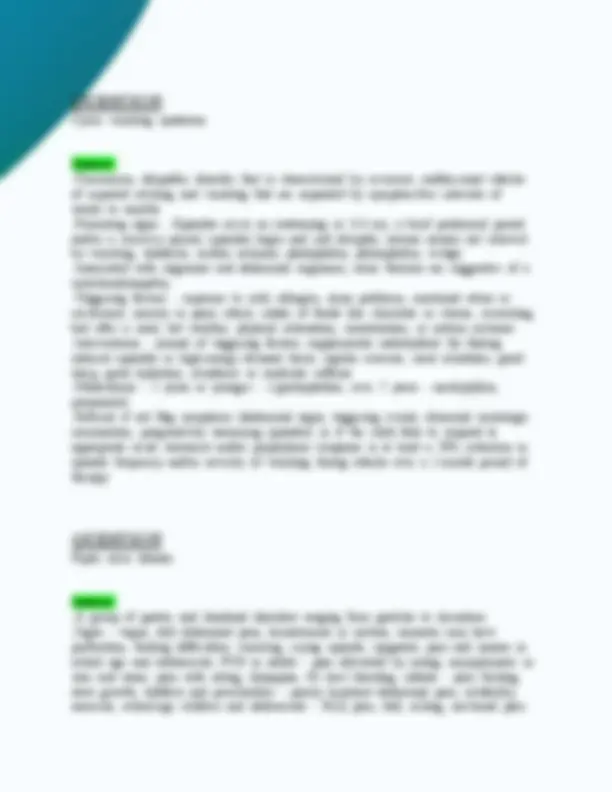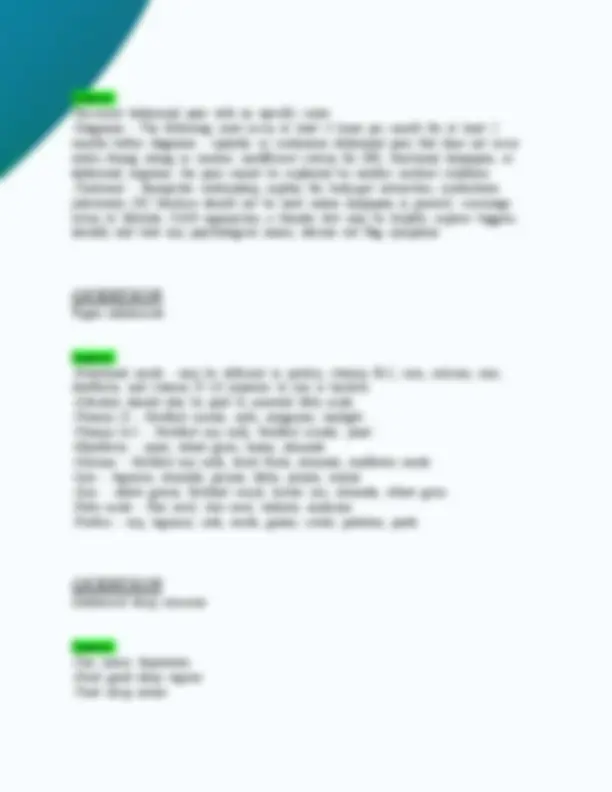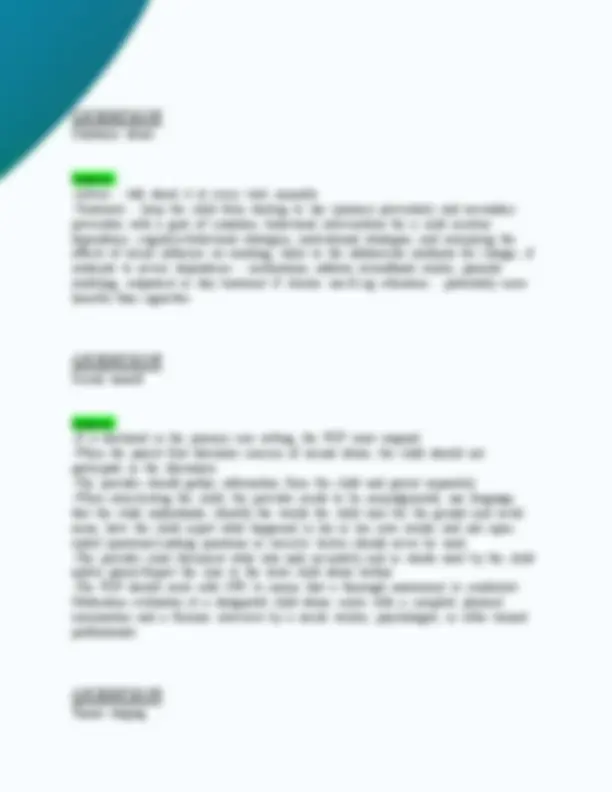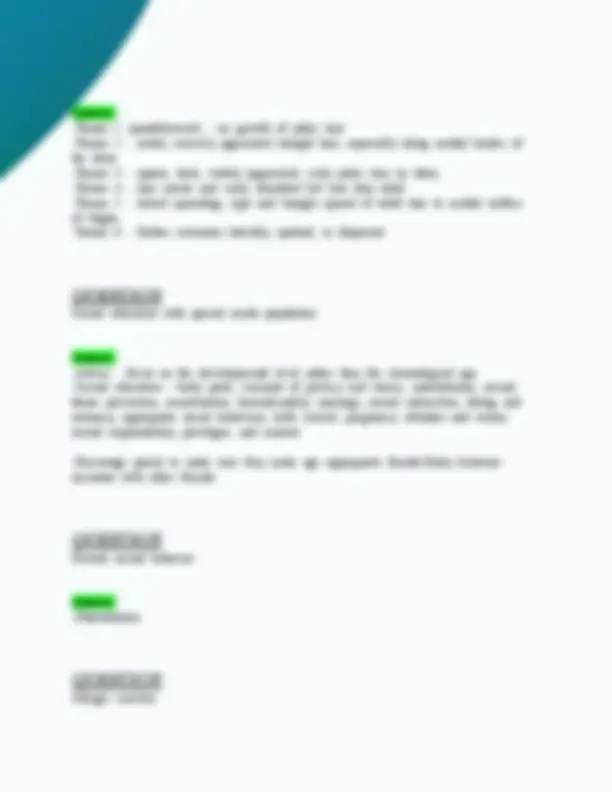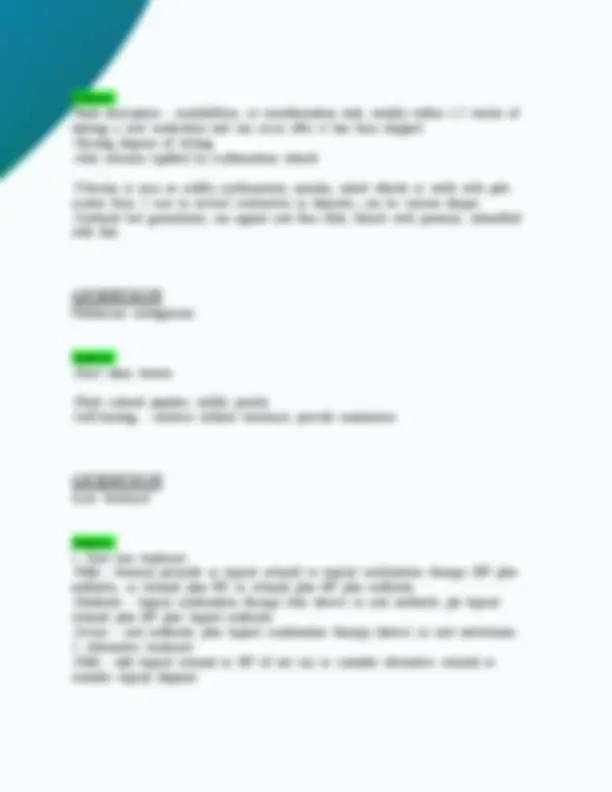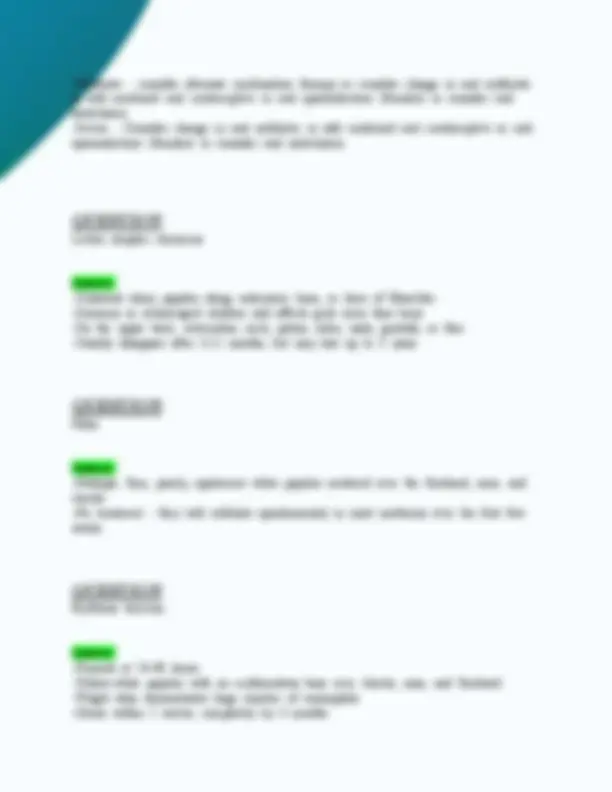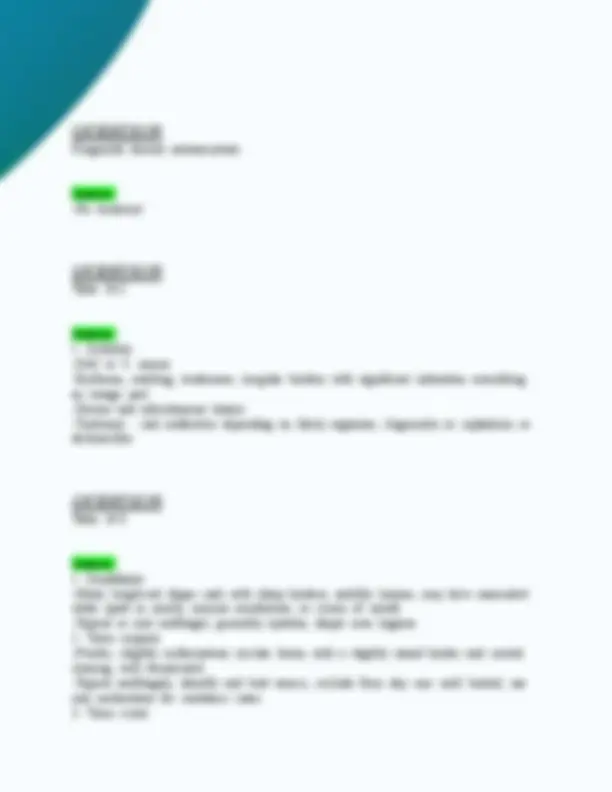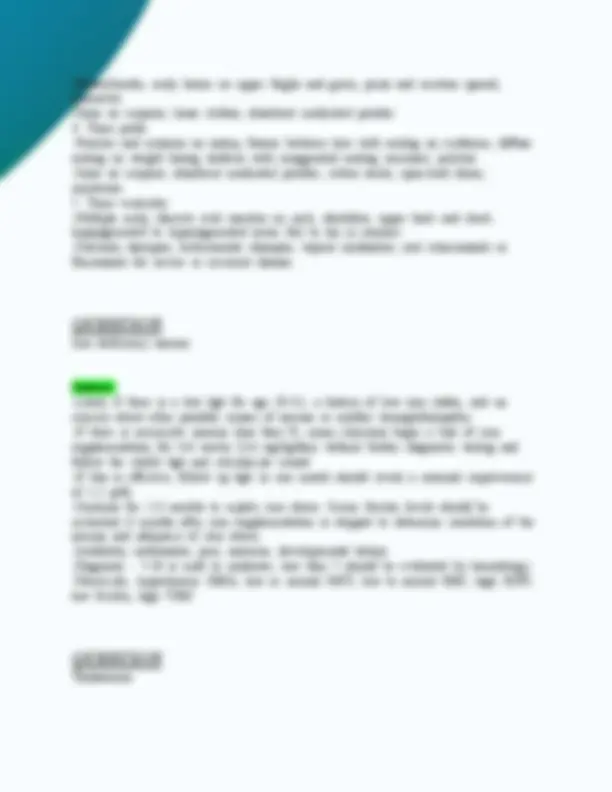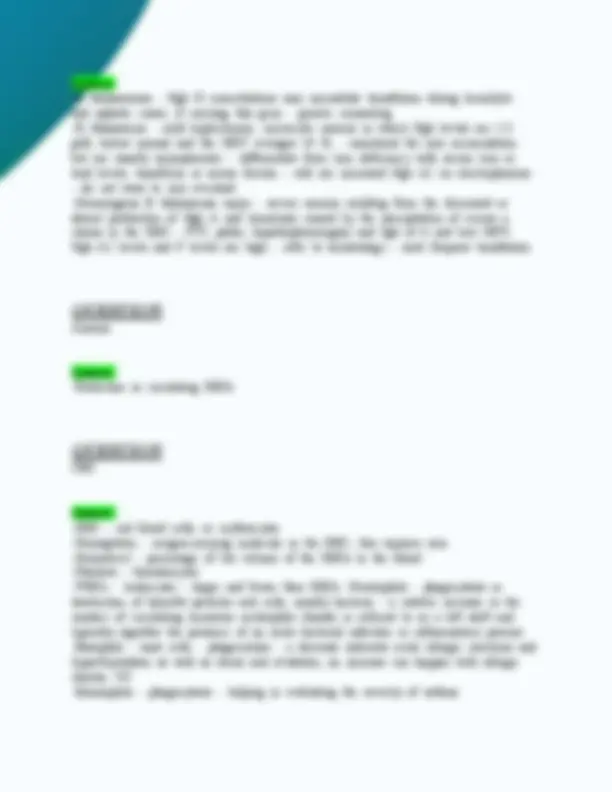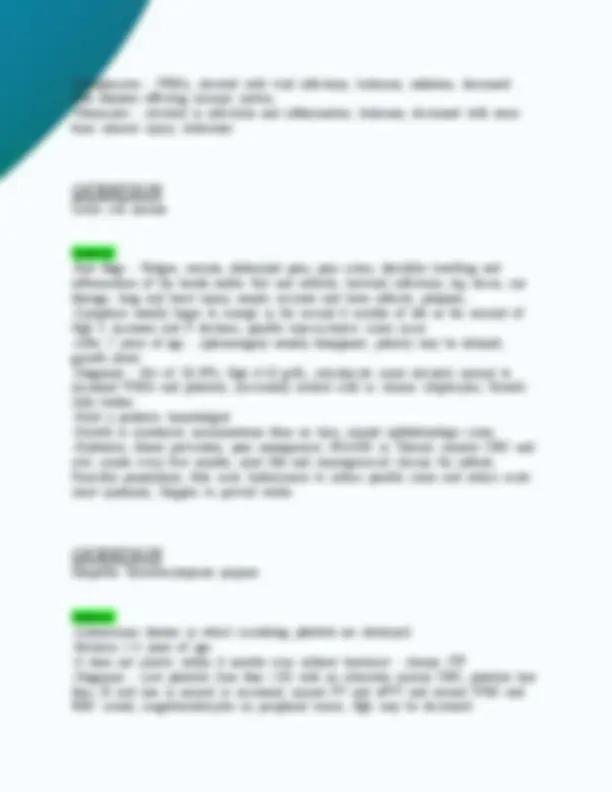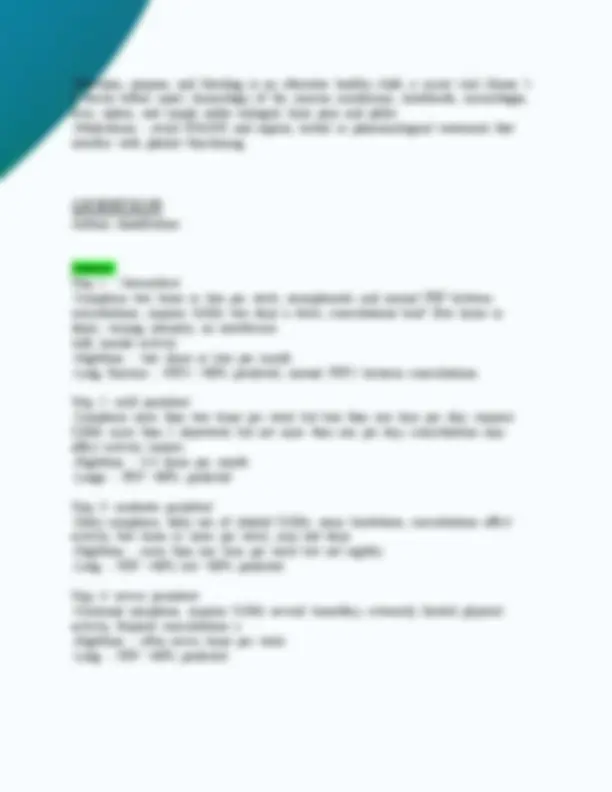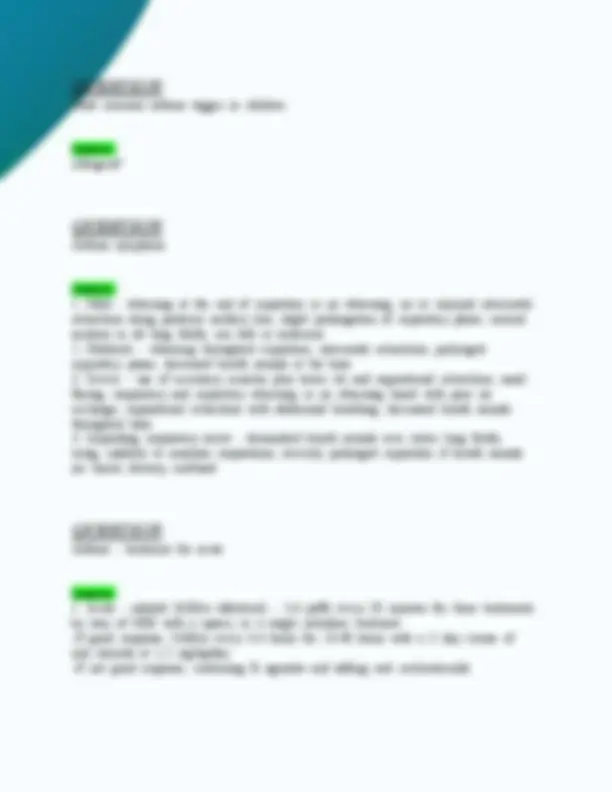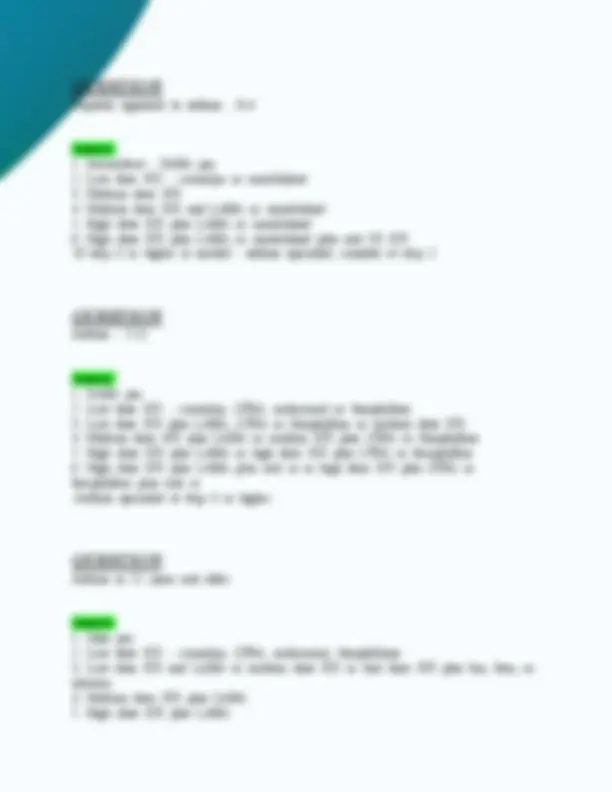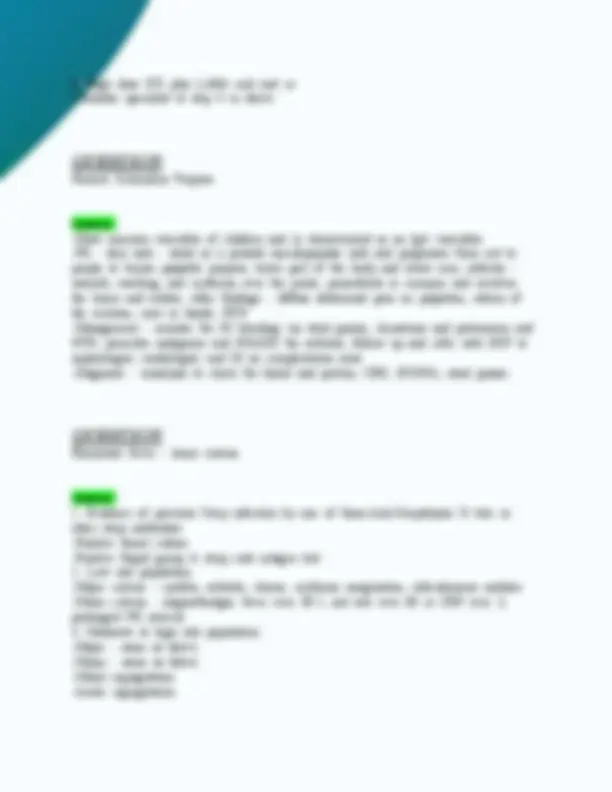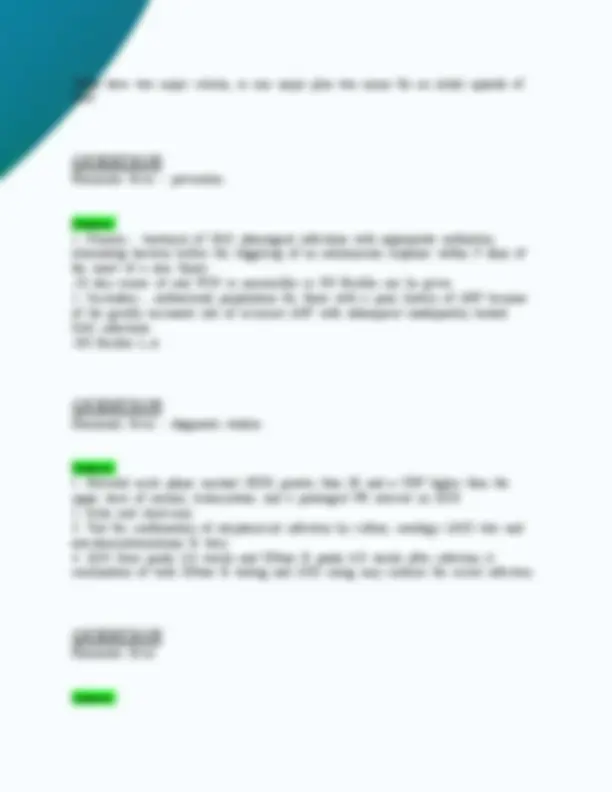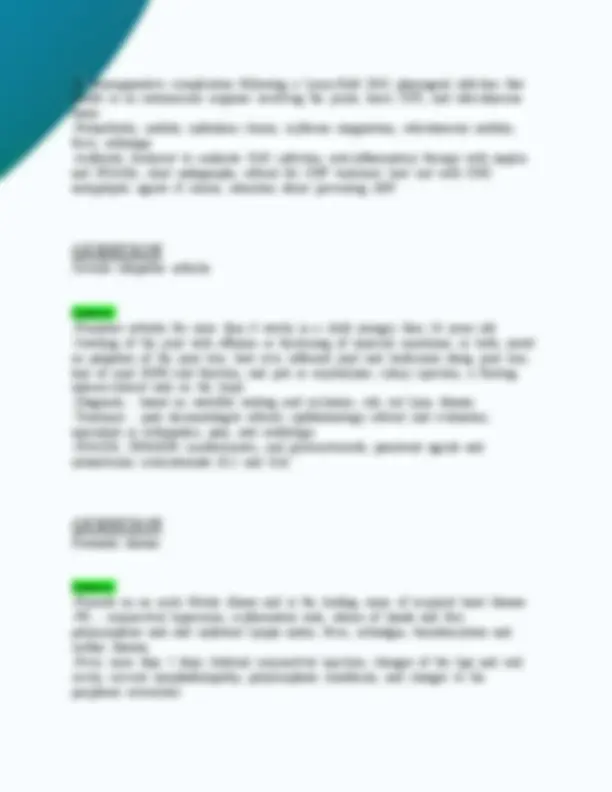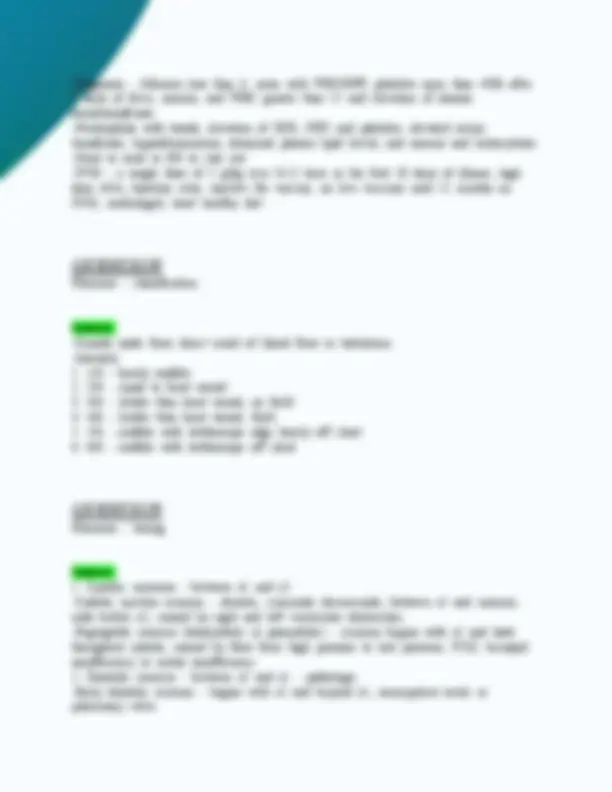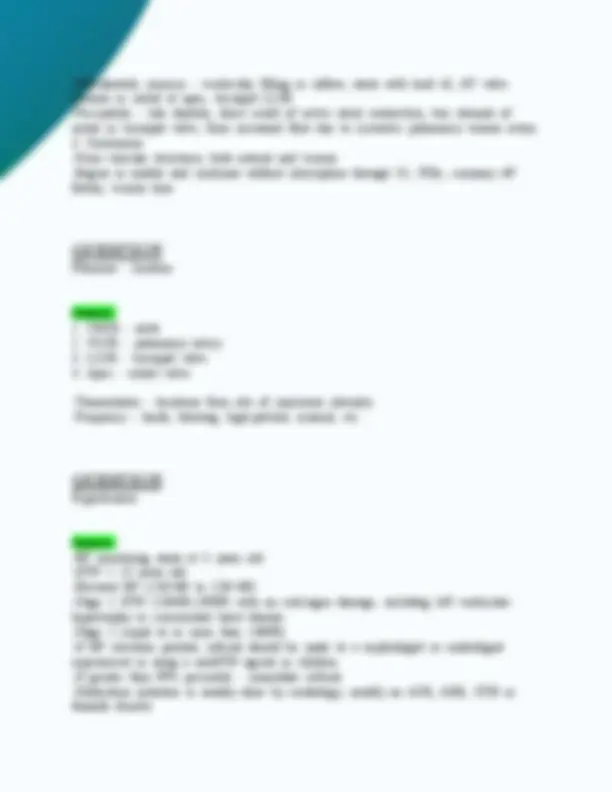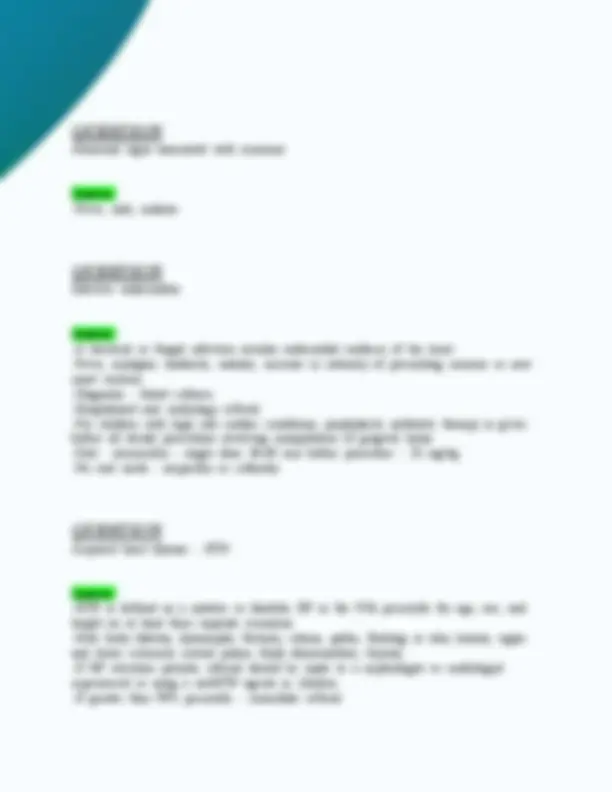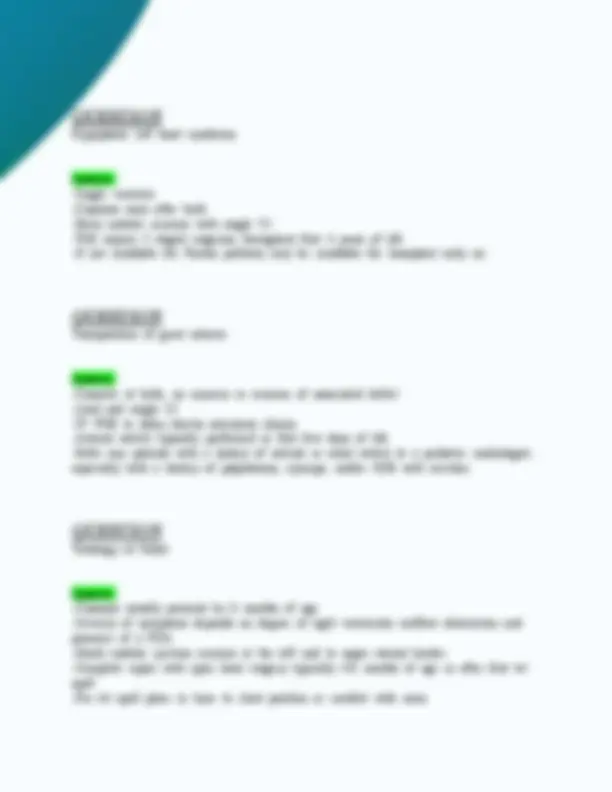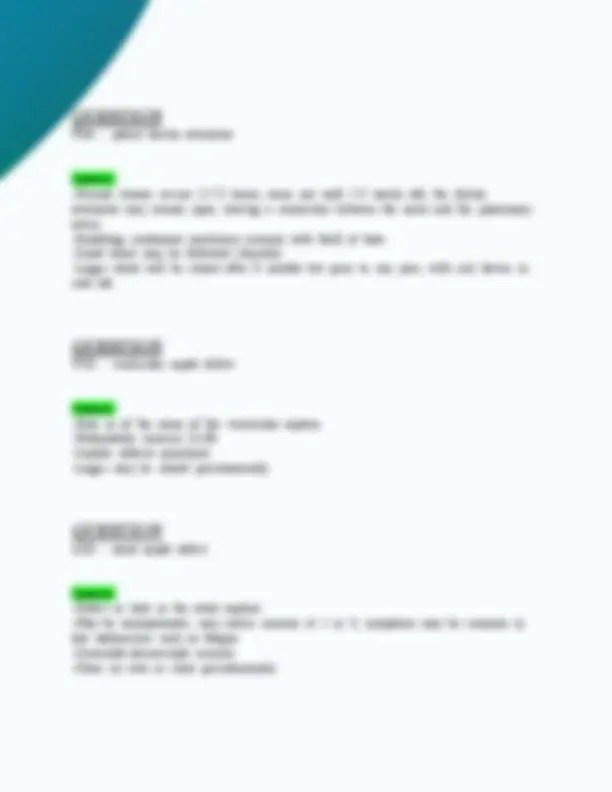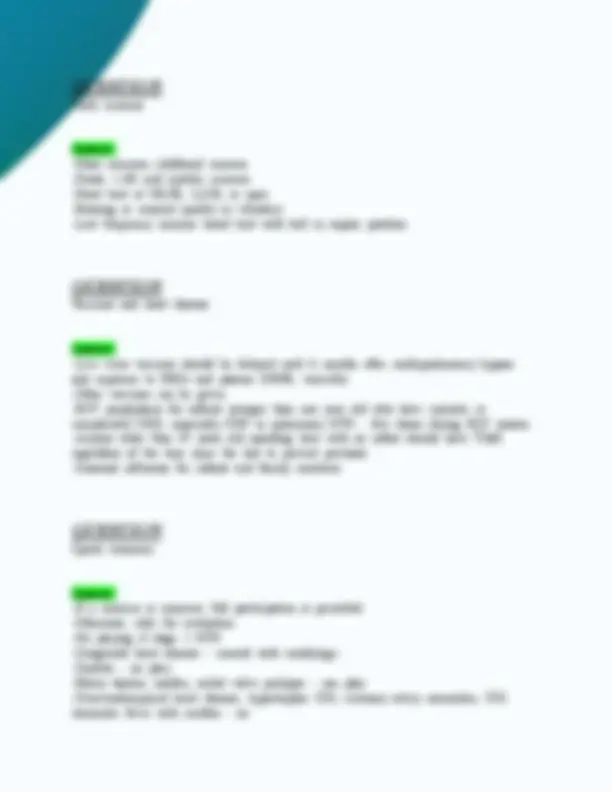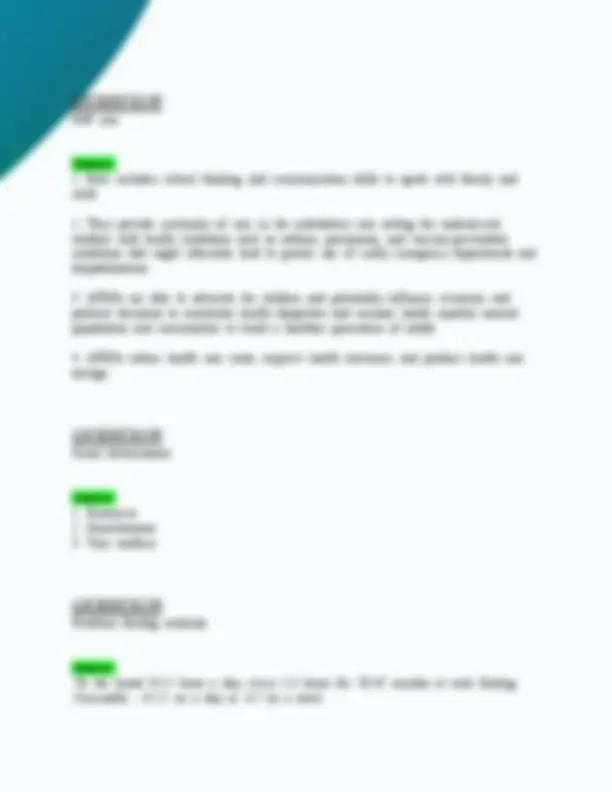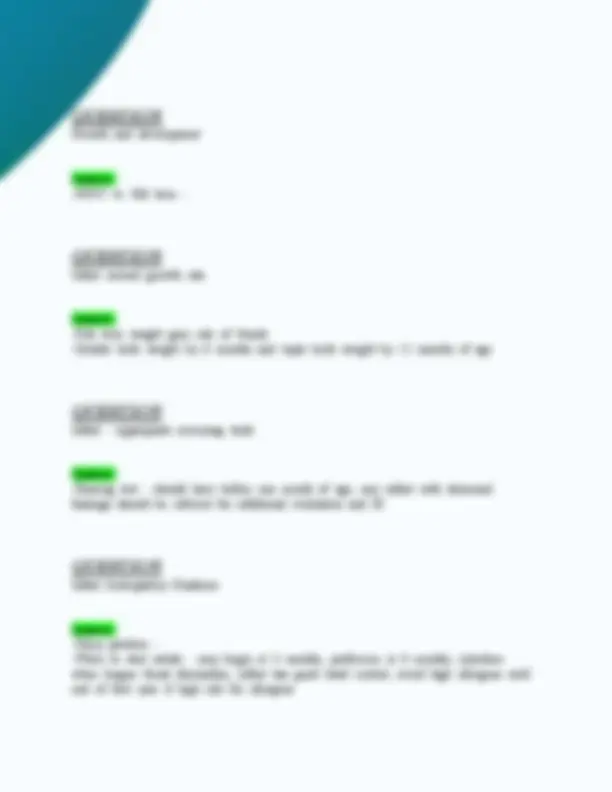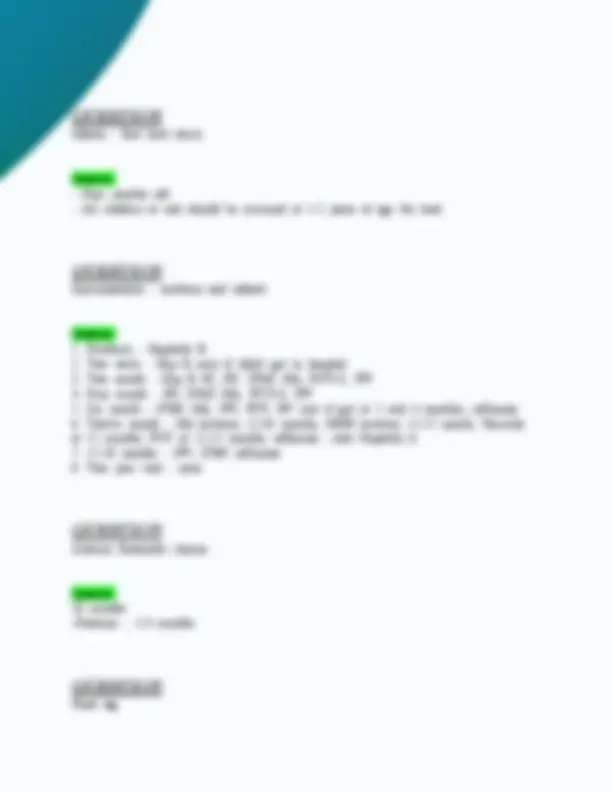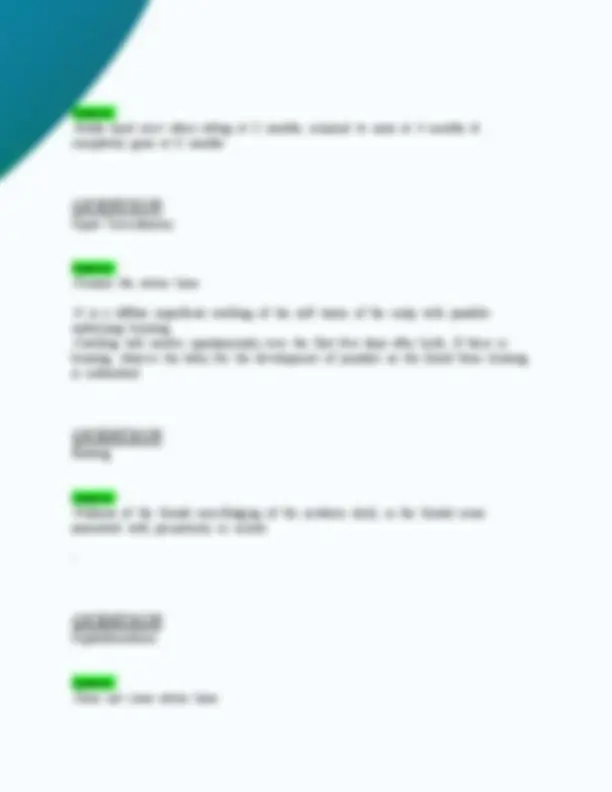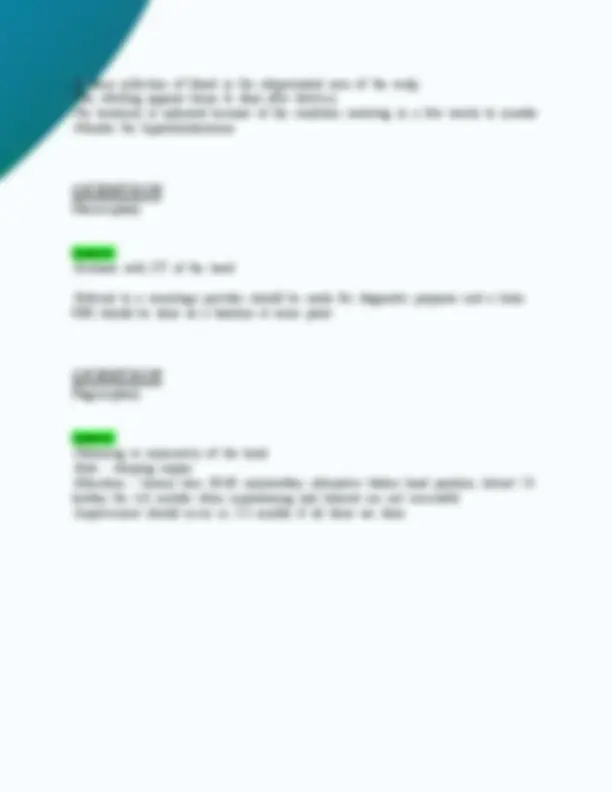Download Final Exam: NU664A/ NU 664A (New 2025/ 2026 Update) Guide| Qs & As| 100% Correct- Regis and more Exams Nursing in PDF only on Docsity!
Final l Exam: l NU664A/ l NU l 664 A l (New l
2025/ l 2026 l Update) l Primary l Care l of l
Child l I l Guide| l Qs l & l As l | l Grade l A| l
100% l Correct l (Verified l Answers)- l Regis
QUESTION
Pediculosisl capitis Answer:
- Akal lice
- Canl usuallyl visualizel livel licel andl itchingl ofl thel scalp,l excoriationl tol backl ofl headl
- Canl bel treatedl withl OTCl licel treatments,l butl canl bel resistant,l sol usuallyl permethrinl 5%
- Alll overl thel scalp,l showerl cap,l sleepl overl night,l thenl washl andl removel itl alll
- Mustl removel nits
QUESTION
Tineal Corporis Answer:
- Annularl lesions,l centrall clearing,l scalyl andl flaky
- Treatl withl antifungall creaml likel miconazolel orl clotrimazolel
- Don'tl havel tol scrape,l typicallyl wel treatl basedl onl visuall diagnosisl unlessl notl improvedl
- Akal ringworm
QUESTION
Tineal Capitis Answer:
- Samel annularl lesionl asl corporis,l flakingl tol thel scalpl
- Cannotl bel treatedl topically
- Firstl linel isl griseofulvinl
- Tastel badl sol educatel parentsl onl thisl
- Labl workl withl long-terml treatmentl - l CBC,l LFTSs,l andl renall function
QUESTION
HSVl 1 Answer:
- Usuallyl presentsl asl clusterl ofl vesiclesl withl erythematousl basel somewherel tol edgel ofl lipsl orl onl lips
- Liquidl diphenhydraminel alonel orl combinedl withl aluminuml hydroxidel orl magnesiuml hydroxidel asl 1:1l rinsel (Maxl ofl 5 l mg/kg/dl diphenhydraminel sincel itl canl bel swallowed);l itl canl bel appliedl tol thel lesionsl withl cotton-tippedl swabsl
- Tol distinguishl betweenl thisl andl HSV2l - l groupedl vesiclesl andl ulcerationl withl edema,l primaryl lesionsl onl vaginall mucosa,l labial orl perineuml inl femalesl orl onl penilel shaftl orl perineuml inl males
- Alsol virall cultures
QUESTION
Contactl dermatitis Answer:
- Erythematousl rashl localizedl tol areal ofl irritantl
- Topicall corticosteroidsl usedl 2 - 3 l timesl dailyl givel reliefl inl 2 - 3 l days
QUESTION
Folliculitis Answer:
- Erythematousl papulesl centeredl aroundl hairl folliclesl
- SJSl treatmentl isl thel same
QUESTION
Tineal versicolor Answer:
- Superficiall fungall infectionl thatl tendsl tol bel persistentl andl occursl onl thel trunkl
- Causedl byl yeastl likel organism,l M.l furfurl andl occursl morel commonlyl inl adolescents
- Seleniuml sulfidel 2.5%l lotionl orl 1%l shampool appliedl inl al thinl layerl severall handl widthsl beyondl lesionsl forl 30 l minutesl twicel al weekl forl 2 - 4 l weeksl followedl byl monthlyl applicationsl forl 3 l monthsl tol helpl preventl recurrencesl
- Olderl adolescentsl canl usel ketoconazolel 2%l
- Orall antifungall treatmentsl forl severel orl resistantl casesl - l fluconazole
QUESTION
Psoriasis Answer:
- Al chronic,l papulosquamousl skinl disorderl withl spontaneousl remissionsl andl exacerbations,l isl characterizedl byl thickl silveryl scales,l variedl distributionl patterns,l andl isomorphicl responsel
- Thel scalp,l elbows,l knees,l buttocks
- Sunl exposure,l preventl sunburn;l emollientl creamsl (Eucerin,l Aquaphor),l topicall steroidsl 2 - 3 l timesl al dayl forl 2 - 3 l weeksl
- Referrall tol dermatologyl - l sulfurl orl salicylicl acid;l anthralinl ointment,l calcipotriol,l UVl lightl therapy,
QUESTION
Pityriasisl rosea Answer:
- Self-limitingl papulosquamousl disease
- Heraldl spotl orl patchl - l solitary,l ovoid,l slightlyl erythematousl lesionl withl al finelyl scaledl slightlyl elevatedl borderl thatl enlargesl quicklyl withl centrall clearing;l trunk,l upperl arm,l neck,l orl thigh
- Secondaryl generalizedl lesionsl appearl thatl arel symmetric,l smalll macularl tol papular,l thinl andl roundl tol oval;l christmasl treel pattern
QUESTION
Impetigo Answer:
- Commonl contagiousl bacteriall infectionl ofl thel superficiall layersl ofl thel skinl
- Nonbullous,l classic,l orl commonl - l 1 - 2 l mml erythematousl papulesl orl pustulesl thatl progressl tol vesiclesl orl bullae,l whichl rupture,l leavingl moist,l honey-colored,l crustyl lesionsl onl mildlyl erythematous,l erodedl skin
- Commonl face,l hands,l neck,l extremities,l orl perineum
- Treatmentl - l topicall antibioticsl ifl superficial,l nonbullous,l orl localizedl tol al limitedl area;l bacitracin,l polymyxinl B,l neomycin;l mupirocinl andl retapamulinl arel consideredl betterl duel tol resistancel
- Widespreadl infectionl - l orall antibioticsl - l Cephalexin,l Augmentin
- Sl aureusl orl S.l pyogenes
- Moisturizel skin,l cleansel andl breakl inl skin
QUESTION
Transientl erythroblastopenial ofl childhood Answer:
- Selfl limited,l withl recoveryl 1 - 2 l monthsl afterl diagnosis
- Nol specificl treatmentl isl indicated,l althoughl transfusionsl mayl bel requiredl forl severel anemial
- Al referrall tol hematologistl mayl bel needed,l butl typicallyl youl willl havel tol havel closel observationl forl symptomsl andl andl labl values
- Occursl inl previouslyl healthyl childrenl betweenl 6 l months-l 3 l yearsl ofl age;l mayl havel hadl al precedingl infection
QUESTION
Transitionl tol milk Answer:
- Milkl shouldl bel limitedl tol <24l ounces/dayl (16l isl good)l duel tol lackl ofl ironl andl interferencel withl intakel ofl otherl nutrientsl
- Wholel milkl andl nol skiml
- Wholel milkl untill 2 l yearsl
- Discussl atl 12 l months
QUESTION
Temperl tantrums Answer:
- Reassurel it'sl normall andl nothingl isl wrong
QUESTION
Toddlersl - l identificationl ofl redl flags Answer:
QUESTION
Otitisl External - l treatment Answer:
- Diffusel inflammationl ofl thel EACl andl canl involvel thel pinnal orl TMl
- Edema,l discharge,l andl erythema
- OEl resultsl whenl thel protectivel barrierl inl thel EACl arel damagedl byl mechanicall orl chemicall mechanisms
- Eardropsl - l Ciprodexl - l ciprofloxacinl andl dexamethasone;l usuallyl containingl aceticl acidl orl antibioticl withl andl withoutl corticosteroidl dropsl arel thel treatmentl ofl choice
- Shouldl improvel withinl 7 l days,l butl resolutionl mayl takel twol weeksl
- Routinel follow-upl isl notl needed
- Ifl symptomsl worsenl afterl treatmentl orl nol improvementl afterl al week,l al referrall tol ENTl isl indicated
- Ifl notl improvedl withinl 72 l hoursl - l recheckl tol confirml diagnosis
QUESTION
Acutel otitisl media Answer:
- 1stl choicel medicationl - l Amoxicillinl 80 - 90 l mg/kg/dayl dividedl twicel al dayl forl 5 - 7 l ifl overl two;l ifl underl 2 l - l 10 l daysl
- 2ndl failurel choicel - l Augmentinl 80 - 90 l mg/kg/dayl BID
QUESTION
Pickyl eater Answer:
- Itl isl thel parentsl jobl tol providel thel childl withl nutritiousl foodsl andl thel child'sl jobl tol decidel howl muchl tol eat
- Startl withl smalll portions
- Discouragel parentsl froml makingl separatel meals
- Changesl inl eatingl habitsl arel causedl byl developmentall changes
- Dol notl force
- 1 l tablespoonl perl eachl yearl ofl agel orl 1/3l tol 1/4l anl adultl portion
QUESTION
Preschoolerl growthl andl development Answer:
QUESTION
Chalazion Answer:
- Al chronicl sterilel inflammationl ofl thel eyelidl resultingl froml al lipogranulomal ofl thel meibomianl glands,l whichl linel thel posteriorl marginsl ofl thel eyelids
- Hotl compresses
- Referl tol al ophthalmologistl forl surgicall incisionl orl topicall intralesionall corticosteroidl injectionsl ifl thel conditionl isl unresolvedl orl thel lesionl causesl cosmeticl concernsl
- Canl causel astigmatisml asl al resultl ofl pressurel onl thel orbit
QUESTION
Hordeolum Answer:
- Al stye,l isl anl infectionl ofl eitherl thel sebaceousl glands,l thel eyelidsl (externall hordeolum),l orl thel meibomianl glandsl (internall hordeolum)
- Signsl - l tender,l swollen,l redl furunclel isl seen
- Interventionsl - l rupturel oftenl occursl spontaneouslyl wenl thel furunclel becomesl largel andl al pointl develops;l removall ofl anl eyelashl promotesl rupture;l warm,l moistl compressesl 3 - 4 l timesl al day,l 10 - 15 l minutesl eachl time,l hygienel forl thel eyel withl al cotton-tippedl applicatorl orl cleanl washclothl withl no-tearsl shampool oncel orl twicel al day;l antistaphylococcall ointment;l nol steroids
- Referl tol anl ophthalmologistl forl incisionl andl drainagel ifl itl doesl notl rupturel onl itsl ownl afterl comingl tol al pointl orl forl multiplel orl recurrentl hordeolum
QUESTION
Blepharitis Answer:
- Anl acutel orl chronicl inflammationl ofl thel eyelashl folliclesl orl meibomianl sebaceousl glandsl ofl thel eyelidsl (orl both)
- Usuallyl bilateral
- Swelling,l erythemal ofl thel eyelidl marginsl andl palpebrall conjunctiva,l flaky,l scalyl debrisl overl eyelidl marginsl onl awakening,l gritty,l burningl feelingl inl eyes,l
- Scrubl eyelashesl andl eyelidsl withl al cottonl tippedl applicatorl orl cleanl washclothl withl no- tearsl shampoo;l warml compresses;l massagel thel lidsl 2 - 4 l timesl al day;l sometimesl anl antistaphylococcall antibioticl (bacitracinl orl erythromycin)l isl usedl oncel dailyl atl bedtimel untill symptomsl subsidel andl forl atl leastl onel week
QUESTION
Retinoblastoma Answer:
- Intraocularl tumorl thatl developsl inl thel retina
- Mostl commonl tumorl inl childhood
- Alll infantsl havel al redl reflexl examl beforel dischargel froml thel newbornl nurseryl andl thereafterl atl everyl healthl maintenancel visitl
- Strabismus,l decreasedl visuall acuity,l unil orl bilaterall whitel pupill describedl asl anl intermittentl glow,l glint,l gleam,l orl glare
- Diagnosisl vial ophthalmicl exam,l US,l orl MRI
- Needl multidisciplinaryl teaml - l mayl needl cryotherapy,l laserl photocoagulopathy,l chemotherapy,l orl enculeationl
- Frequentl follow-upl tol assessl treatmentl andl monitorl forl recurrencel isl criticall tol optimizingl vision
QUESTION
Retinopathyl ofl prematurity Answer:
- Al multifactoriall retinall vascularl pathologicl diseasel primarilyl causedl byl earlyl gestationall agel withl lowl birthl weight
- Abnormall growthl ofl thel retinall vesselsl inl incompletelyl vascularizedl retinasl ofl prematurel infants
- Follow-upl afterl resolutionl - l yearlyl follow-upl ifl ROPl requiredl anyl treatment;l lessl frequentl follow-upl ifl nol treatmentl required;l EI,l low-visionl communityl supportl services,l andl tol familyl supportl groups;l monitorl forl latel sequelael orl ROPl progression
- Disk,l coin-shaped,l orl buttonl batteriesl mustl bel removedl emergently
- Sphericall objectsl arel thel mostl difficultl tol removel andl requirel referrall tol anl otolaryngologist
- Ifl thel objectl isl madel ofl iron,l nickel,l orl cobalt,l al magnetl mayl bel usedl forl retrieval
- Insectsl shouldl bel suffocatedl withl minerall oil,l thenl earl canl bel irrigated,l orl thel childl canl bel referredl tol ENTl forl removal
- Ifl thel foreignl bodyl cannotl bel extractedl onl thel firstl fewl attemptsl orl cannotl bel removedl withoutl riskingl damagel tol thel externall canall orl TM,l orl ifl therel isl worseningl pain,l thenl referl thel childl tol anl ENT
QUESTION
Epiglottitis Answer:
- Al life-threateningl illnessl characterizedl byl inflammationl ofl thel epiglottisl thel aryepiglotticl folds,l andl thel ventricularl bandsl atl thel basel ofl thel epiglottis
- Ifl thisl isl suspectedl - l dol notl examinel thel throat
- Signsl - l inspiratoryl andl sometimesl expiratoryl stridor,l drooling,l aphonia,l andl highl fever,l rapidlyl progressivel respiratoryl obstructionl andl prostration,l flaringl ofl thel alal nasil andl retractionl ofl thel supraclavicular,l intercostal,l andl subcostall spaces,l childl assumesl al hyperextensionl ofl thel neck
- Inl olderl childrenl - l sorel throat,l dysphagia,l stridor,l irritability,l restlessness,l andl brassyl cough;l airwayl obstructionl followsl withinl 2 - 24 l hour;l thel childl sitsl withl armsl back,l trunkl forward,l neckl hyperextended,l andl chinl thrustl forwardl (tripodl position)
- Interventionsl - l airwayl managementl ASAP;l earlyl consultationl withl al pediatricl otolaryngologistl andl anesthesiologistl isl key;l establishl airwayl andl startl antimicrobials;l dol notl placel inl supinel position,l immediatelyl transportl tol thel ER
- Diagnosedl inl thel ORl byl depressingl thel tonguel tol viewl thel swollenl cherry-redl epiglottis
- Nasotracheall intubation,l IVl broad-spectruml antibiotics,l whichl canl includel ampicillin/sulbactam,l cefotaxime,l ceftriaxone,l orl clindamycinl ofl penicillinl allergyl withl thel additionl ofl vancomycinl ifl MRSAl isl suspected;l oxygenl andl respiratoryl support
QUESTION
Communityl acquiredl pneumonia
Answer:
- Drugl ofl choicel - l Azithromycinl 10 l mg/kg/dayl oncel onl dayl 1 l andl thenl 5 l mg/kg/dayl forl thel nextl 4 l days
QUESTION
Appendicitis Answer:
- Inflammationl ofl thel appendixl thel leadsl tol distentionl andl ischemial thatl canl resultl inl necrosis,l perforation,l andl peritonitisl orl abscessl formationl
- Poorlyl definedl periumbilicall pain;l acutel onsetl ofl severel painl isl notl typicall ofl acutel appendicitis;l al shiftingl ofl painl tol thel RLQl mayl occurl afterl al fewl hoursl andl becomel morel intense,l continuous,l andl localized;l nauseal andl vomiting,l anorexia,l stooll withl mucus,l feverl mayl orl mayl notl occurl
- Physicall examl - l involuntaryl guarding,l RLQl reboundl tenderness,l painl overl McBurneyl point,l positivel psoasl signl orl obturatorl sign,l rovsingl signl orl reboundl tenderness
QUESTION
Colic Answer:
- Anl infantl whol isl youngerl thanl 5 l monthsl oldl whenl symptomsl startl andl stop
- Recurrentl andl prolongedl periodsl ofl infantl crying,l fussing,l orl irritabilityl reportedl byl caregiversl thatl occurl withoutl obviousl causel andl cannotl bel preventedl orl resolvedl byl caregiversl
- Nol FTT,l fever,l orl illness
- PEl - l inconsolablel boutsl ofl crying,l whichl occurl withoutl obviousl cause,l oftenl clusteringl inl afternoonl orl evening,l grimacing,l clenchedl fists,l flatus,l drawingl legsl up,l cryingl morel intense
- Twol weekl triall ofl hypoallergenicl formulal orl removingl cow'sl milkl froml mom'sl dietl ifl BFing;l avoidl sorbitol;l encouragel BFing,l triall ofl caffeinel elimination,l swaddlingl infant,l whitel noise,l dol notl overstimulate,l nol exposurel tol tobaccol smoke,l reassurel parents,l nol evidencel tol supportl probiotics
- Mayl needl follow-upl frequently,l seel babyl 2 l weeksl afterl diagnosis
- Historyl - l familyl historyl ofl PUD,l factorsl suchl asl smoking,l alcohol,l aspirin,l NSAIDS,l steroids,l emotionall stress,l sepsis,l hypotension
- Needl forl furtherl interventionl - l H2RAsl orl PPIsl beforel al meal;l eradicationl forl h.l pylori;l PPIsl inl childrenl olderl thanl 1
- Referrall tol al GIl shouldl occurl ifl lackl ofl improvementl orl inabilityl tol weanl offl medications;l historyl ofl hematemesis,l melena,l OBl inl stools,l anemia,l and/orl weightl loss
QUESTION
Celiacl disease Answer:
- Anl immune-mediatedl systemicl disorderl triggeredl byl wheatl glutenl andl relatedl proteinsl inl barleyl andl rye
- Signsl - l diarrhea,l steatorrhea,l weightl loss,l growthl failure,l abdominall pain,l constipation,l extraintestinall symptoms
- Interventionsl - l glutenl freel dietl forl lifel ;l enzymel therapy,l correctingl intestinall barrierl defects
- Testingl - l serologicl testingl ifl firstl degreel relative,l associatedl disorderl orl al suspicion;l glutenl mustl bel eatenl inl morel thanl onel meall forl 6 l weeksl everyl day;l IGA;l ifl positive,l endoscopyl withl biopsy
QUESTION
Dehydration Answer: 1.l Minimall tol nonel (<3%l lossl ofl bodyl weight)l - l well,l alert,l drinksl normally,l normall vitall signs,l tearsl present,l moistl mouthl andl tongue,l skinfoldl withl instantl recoil;l warml extremities,l urinel outputl normal
- Interventionsl - l maintenancel hydrationl (100l ml/kg/24l hrl forl 0 - 10 l kg;l 1000 l mll plusl 50 l ml/kgl forl eachl kgl overl 10 l forl 10 - 20 l kg;l ifl overl 20 l kgl - l 1500 l mll plusl 20 l ml/kgl forl eachl kgl overl 20 l kg)-Ifl lessl thanl 10 l kgl - l 60 - 120 l mll ORSl forl eachl diarrheall stooll orl vomitingl episode
- Ifl greaterl thanl 10 l kgl - l 120 - 240 l mll ORSl forl eachl diarrheall stooll orl vomitingl episode 2.l Mildl tol moderatel dehydrationl (3%-9%l lossl ofl bodyl weight)l - l normal,l fatiguedl orl restless,l irritable;l thirsty,l eagerl tol drink,l normall tol increasedl HRl andl normall tol decreasedl qualityl ofl pulses;l normall orl fastl breathing;l slightlyl sunkenl eyes;l decreasedl
tears;l mouthl andl tonguel dry;l skinfoldl recoill inl <2l seconds;l prolongedl capl refill,l cooll extremities,l decreasedl urinel output
- Interventionsl - l ORSl 50 - 100 l ml/kgl bodyl weightl overl 3 - 4 l hoursl orl 10 - 20 l ml/kg/hour
- Maintenancel - l samel asl above
- Ongoingl lossesl - l samel asl ORSl above 3.l Severel (>9%l ofl bodyl weight)l - l apathetic,l lethargic,l unconscious;l drinksl poorly,l unablel tol drink;l tachycardia,l bradycardial inl severel cases;l weak,l thready,l orl impalpablel pulses;l deepl breathing,l deeplyl sunkenl eyes;l absentl tears;l parchedl mouthl andl tongue;l recoill skinl inl >2l seconds;l prolongedl capl refill;l extremitiesl arel cold,l mottled;l cyanotic;l minimall urinel output
- Interventionsl - l LRl orl NSl IVl inl bolusesl ofl 20 l ml/kgl bodyl weightl untill perfusionl andl mentall statusl improve;l ifl afterl 60 - 80 l ml/kgl givenl thenl otherl causesl ofl ofl shockl shouldl bel considered;l thenl administerl 100 l ml/kgl bodyl weightl ORSl overl 4 l hoursl orl 5%l dextrosel inl 1/2l NSl IVl atl twicel thel maintenancel rate
- Maintenancel - l same-Ongoingl lossesl - l inl unablel tol drink,l administerl throughl NGl orl administerl 5%l dextrosel in
QUESTION
Intussusception Answer:
- Involvesl al sectionl ofl intestinel beingl pulledl antegradel intol adjacentl intestinel withl thel proximall bowell trappedl inl thel distall segment
- Signsl - l intermittent,l colickyl abdominall pain,l vomiting,l andl bloodyl mucousl stools;l screamingl withl drawingl upl thel legsl withl periodsl ofl calm,l sleeping,l orl lethargyl betweenl episodes;l feverl mayl orl mayl notl bel present
- Interventionl - l emergencyl managementl andl consultationl withl al pediatricl radiologistl andl andl al pediatricl surgeon;l rehydration,l gastricl decompression,l surgeryl ifl perforation,l peritonitis,l orl hypovolemicl shockl isl suspectedl orl radiologicl reductionl fails;l IVl antibioticsl tol coverl perforation;l observationl followedl radiologicl reductionl isl recommended
- Returnl withl anyl recurrencel ofl symptomsl arel required,l andl closel phonel follow-upl forl upl tol 72 l hoursl isl prudent
QUESTION
Recurrentl abdominall pain
QUESTION
Substancel abuse Answer:
- Advicel - l talkl aboutl itl atl everyl visit;l annually
- Treatmentl - l keepl thel childl froml startingl tol usel (primaryl prevention)l andl secondaryl preventionl withl al goall ofl cessation;l behaviorall interventionsl forl al mildl nicotinel dependence;l cognitive-behaviorall strategies,l motivationall strategies,l andl examiningl thel effectsl ofl sociall influencel onl smoking;l tailorl tol thel adolescentsl readinessl forl change;l ifl moderatel tol severel dependencel - l medications;l addressl secondhandl smoke;l parentall modeling;l outpatientl orl dayl treatmentl ifl chronicl use-E-cigl educationl - l potentiallyl morel harmfull thanl cigarettes
QUESTION
Sexuall assault Answer:
- Ifl itl disclosedl inl thel primaryl carel setting,l thel PCPl mustl respond
- Whenl thel parentl firstl discussesl concernl ofl sexuall abuse,l thel childl shouldl notl participatel inl thel discussion
- Thel providerl shouldl gatherl informationl froml thel childl andl parentl separately
- Whenl interviewingl thel child,l thel providerl needsl tol bel nonjudgmental,l usel languagel thatl thel childl understands,l identifyl thel wordsl thel childl usesl forl thel genitall andl rectall areas,l havel thel childl reportl whatl happenedl inl hisl orl herl ownl words,l andl askl open- endedl questions-Leadingl questionsl orl coercivel tacticsl shouldl neverl bel used
- Thel providerl mustl documentl whatl wasl saidl accuratelyl andl inl wordsl usedl byl thel childl and/orl parent-Reportl thel casel tol thel locall childl abusel hotline
- Thel PCPl shouldl workl withl CPSl tol ensurel thatl al thoroughl assessmentl isl conducted- Medicationl evaluationl atl al designatedl childl abusel centerl withl al completel physicall examinationl andl al forensicl interviewl byl al sociall worker,l psychologist,l orl otherl trainedl professionals
QUESTION
Tannerl staging
Answer:
- Tannerl 1 l (preadolescent)l - l nol growthl ofl pubicl hair
- Tannerl 2 l - l initial,l scarcelyl pigmentedl straightl hair,l especiallyl alongl mediall borderl ofl thel labia
- Tannerl 3 l - l sparse,l dark,l visiblyl pigmented,l curlyl pubicl hairl onl labia
- Tannerl 4 l - l hairl coarsel andl curly,l abundantl butl lessl thanl adult
- Tannerl 5 l - l laterall spreading;l typel andl trianglel spreadl ofl adultl hairl tol mediall surfacel ofl thighs
- Tannerl 6 l - l furtherl extensionl laterally,l upward,l orl dispersed
QUESTION
Sexuall educationl withl speciall needsl population Answer:
- Advicel - l focusl onl thel developmentall levell ratherl thanl thel chronologicall age
- Sexuall educationl - l bodyl parts,l conceptsl ofl privacyl andl choice,l masturbation,l sexuall abusel prevention,l menstruation,l homosexuality,l marriage,l sexuall interaction,l datingl andl intimacy,l appropriatel sociall behaviors,l birthl control,l pregnancy,l attitudesl andl values,l sexuall responsibility,l privileges,l andl consent
- Encouragel parentl tol makel surel theyl makel agel appropriatel friends-Riskyl behaviorl increasesl withl olderl friends
QUESTION
Normall sexuall behavior Answer:
QUESTION
Allergicl reaction

